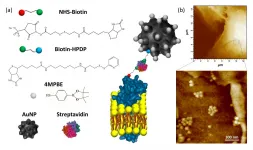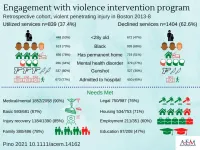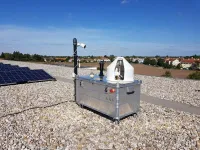'Island of Rats' recovers
Island birds, seashore ecosystem return to natural balance after invasive rodent removal
2021-03-08
(Press-News.org) Along the western edge of Alaska's Aleutian archipelago, a group of islands that were inadvertently populated with rodents came to earn the ignominious label of the "Rat Islands." The non-native invaders were accidentally introduced to these islands, and others throughout the Aleutian chain, through shipwrecks dating back to the 1700s and World War II occupation. The resilient rodents, which are known to be among the most damaging invasive animals, adapted and thrived in the new setting and eventually overwhelmed the island ecosystems, disrupting the natural ecological order and driving out native species.
A coordinated conservation effort that removed the rats from one of the islands formerly known as Rat Island has become a new example of how ecosystems can fully recover to their natural state in little more than a decade. The ecological rebound at newly named Hawadax Island (a return to the original Aleut name meaning "the island over there with two knolls") extended from land to the island's interconnected marine community. Results of a study published in Scientific Reports and led by a University of California San Diego researcher has documented the remarkable recovery.
"We were surprised that the level of recovery unfolded so quickly--we thought it could be longer," said Carolyn Kurle, an associate professor in the UC San Diego Division of Biological Sciences Section of Ecology, Behavior and Evolution and lead author of the new study, which includes researchers from UC Santa Cruz, Island Conservation, the U.S. Fish and Wildlife Service and The Nature Conservancy.
Kurle has taken part in research expeditions to more than 35 of the islands in the Aleutian chain. She and her colleagues conducted surveys at Hawadax in 2008 when the invasive rodents dominated the island ecosystem. As a new, direct predator to native island species, the rats unleashed a cascade of disruption for the island's food chain. They preyed upon shore bird eggs and chicks, which nearly wiped out the island's breeding shorebird population. Without birds consuming herbivorous seashore invertebrates such as snails and limpets, the island's intertidal plant-eaters flourished, significantly driving down the abundance of the marine kelp.
To reverse these effects, a coordinated conservation strategy to save the native species on Hawadax removed the rats in 2008. The effort presented a rare case in which researchers were able to compare ecosystem data from surveys during rat dominance with a recovering ecosystem five years later and a fully recovered system after 11 years.
"You don't often get the opportunity to return to a remote location and collect data after the fact," said Kurle, who noted that the researchers also compared the survey data with naturally balanced ecosystems on neighboring islands that had never been occupied with rats. "Sometimes it's hard to say that a conservation action had any sort of impact, but in this particular case we took a conservation action that was expensive and difficult, and we actually demonstrated that it worked. But we didn't expect it to be so fast."
With the rats removed at Hawadax, the seabirds returned and are again consuming the seashore invertebrates, which has allowed the recovery and rebound of the kelp community.
"Invasive rats are almost always direct predators of native animals when they become introduced on islands," said Kurle. "So when the birds returned it led to an entirely different structure in the marine community on this island. It now has a structure that more closely resembles what we observe on islands that have never had rat invaders."
The researchers say more studies that focus on understanding and measuring both direct and indirect impacts of invaders, and how inter-connected communities respond following removal of those impacts, are needed to underscore the broad conservation successes associated with invasive species eradication, especially on islands.
"This study both confirms the profound impacts of introduced species like rats across entire sensitive island ecosystems while at the same time demonstrating the remarkable conservation benefits of their removal," said Donald Croll, study co-author and professor in the Ecology and Evolutionary Biology Department at UC Santa Cruz.
INFORMATION:
The full authors list includes: Carolyn Kurle, Kelly Zilliacus, Jenna Sparks, Jen Curl, Mila Bock, Stacey Buckelew, Jeffrey Williams, Coral Wolf, Nick Holmes, Jonathan Plissner, Gregg Howald, Bernie Tershy and Donald Croll.
The research was funded in part by the U.S. Fish and Wildlife Service and the National Fish and Wildlife Foundation and the eradication was conducted by Island Conservation, the U.S. Fish and Wildlife Service and The Nature Conservancy.
[Attachments] See images for this press release:

ELSE PRESS RELEASES FROM THIS DATE:
2021-03-08
Tocilizumab, an anti-inflammatory drug used to treat rheumatoid arthritis, improves outcomes in severely ill COVID-19 patients, finds the results of a new trial conducted in hospitals across India -- one of the world's most ethnically diverse countries. Researchers from the University of Bristol and Medanta Institute of Education and Research in India who led the study, published in The Lancet Respiratory Medicine, say it adds to existing evidence supporting the drug's use in critically ill patients.
Conducted in 12 public and private hospitals across India, the COVID ...
2021-03-08
Trolling and extreme levels of abuse can kill an online campaign but momentum can be maintained, and the energy and morale of exhausted activists effectively restored, by tactical retreat and taking time out, new research into the landmark 'No More Page 3' campaign in the United Kingdom shows.
Dr. Sarah Glozer of the University of Bath School of Management and Dr. Lauren McCarthy of the Royal Holloway University of London School of Business and Management studied the 'No More Page 3' campaign, which from 2012 lobbied The Sun mass-circulation newspaper to stop publishing a photo of a topless woman on page 3, a daily feature launched in 1970. Page 3, the No More Page 3 campaign argued, was a symbol of institutionalised sexism. The Sun removed the Page 3 feature ...
2021-03-08
The earliest multicellular organisms may have lacked heads, legs, or arms, but pieces of them remain inside of us today, new research shows.
According to a UC Riverside study, 555-million-year-old oceanic creatures from the Ediacaran period share genes with today's animals, including humans.
"None of them had heads or skeletons. Many of them probably looked like three-dimensional bathmats on the sea floor, round discs that stuck up," said Mary Droser, a geology professor at UCR. "These animals are so weird and so different, it's difficult to assign them to modern categories of living organisms just by looking at them, and it's not like we can extract their DNA -- we can't."
However, well-preserved fossil records ...
2021-03-08
Over 10,000 people in Europe use an assistance dog; think of guide dogs for people with a visual impairment, hearing dogs for people with a hearing impairment, medical response service dogs and psychiatric service dogs.
According to a UN-agreement and the Dutch law, these dogs are welcome in stores, hospitals and other public places. However, in practice, many assistance dog users and their dogs are regularly refused entry. In the Netherlands, four out of five assistance dog users indicate that they regularly experience problems with this.
Often, hygiene reasons are ...
2021-03-08
Researchers at the UAB have designed minimalist biostructures that imitate natural enzymes, capable of carrying out two differentiated and reversibly regulated activities thanks to a unique combination of structural and functional properties. The strategy used opens the door to the creation of "intelligent" nanomaterials with tailor-made combinations of catalytic functions.
There is an increasing interest in synthetic systems that can execute bioinspired chemical reactions without requiring the complex structures that characterise enzymes in their components. One of the most explored approaches is the self-assembly of peptides - molecules smaller than proteins - due to their biocompatibility and how their structural and functional properties can be controlled.
Researchers from the ...
2021-03-08
Several processes in the human body are regulated by biochemical reactions involving hydrogen peroxide (H2O2). Although it can act as a 'secondary messenger', relaying or amplifying certain signals between cells, H2O2 is generally toxic because of its oxidant character. The latter means that it converts (oxidizes) biochemical molecules like proteins and DNA. The oxidizing property of H2O2 is of potential therapeutic relevance for cancer, though: deliberately causing tumor cells to increase their H2O2 concentration would be a way to destroy them. In light of this, but also for monitoring pathologies associated with H2O2 overproduction, it is crucial to have a means to reliably quantify hydrogen peroxide concentrations in the extracellular environment. Now, Leonardo Puppulin ...
2021-03-08
A team of researchers from the CHUM Research Centre has identified new biomarkers associated with the severity of COVID-19 in infected patients.
Recent scientific literature has shown that the immune response plays a central part in the severity of COVID-19 disease. Understanding the immune responses generated during the course of the disease is therefore essential to determine which patients are at highest risk for serious complications and death from the disease.
In a new study published in the Journal of Clinical Investigation, scientists and clinicians led by Dr.?Catherine Larochelle, researcher at the CHUM Research Centre, have ...
2021-03-08
Bacteria integrate genetic material from other bacterial strains more easily than previously thought, which can lead to improved fitness and accelerated evolution. This is shown in a recent study by biophysicists at the University of Cologne. The team analysed genome transfer between bacteria of different lineages. The study was published in the journal PNAS.
In the experiment, the team brought one strain of bacteria into contact with DNA fragments from another strain. The uptake of foreign genetic material is known as horizontal gene transfer -- in contrast to vertical gene transfer, by which genes are inherited from a parent cell of the same lineage. The results show that ...
2021-03-08
DES PLAINES, IL - A Boston violence intervention advocacy program is effectively engaging the client population that hospital-based violence intervention programs (HVIPs) have been designed to support. This is the conclusion of a study titled Boston Violence Intervention Advocacy Program: Challenges and Opportunities for Client Engagement and Goal Achievement, to be published in the March 2021 issue of Academic Emergency Medicine (AEM), a journal of the Society for Academic Emergency Medicine (SAEM).
According to the study, HVIPs should consider which types of client needs prove most challenging to address and which novel strategies will engage vulnerable populations not typically targeted by intervention programs. ...
2021-03-08
The sensor network MUCCnet (Munich Urban Carbon Column network) consists of five high-precision optical instruments that analyze the sun's light spectra. They measure the concentration of the gases carbon dioxide (CO2), methane (CH4) and carbon monoxide (CO). Since each gas has its own unique spectral "fingerprint", concentrations of these gases can be determined in the columns of air between the instruments and the sun.
"By measuring a vertical column of the atmosphere, local disturbances, such as the disproportionate influence of neighboring stacks, can be removed. Therefore, this type of greenhouse gas balancing is considered particularly robust and accurate," says Prof. Jia Chen.
Measurements at five locations in and around Munich
One of MUCCnet's measurement devices is ...
LAST 30 PRESS RELEASES:
[Press-News.org] 'Island of Rats' recovers
Island birds, seashore ecosystem return to natural balance after invasive rodent removal






